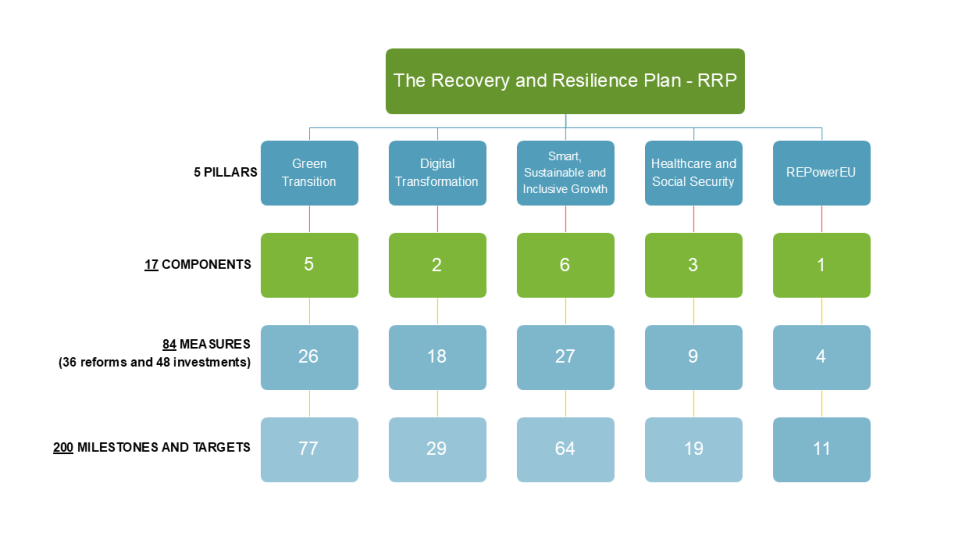About the Recovery and Resilience Plan
The content of the website is in the process of being updated in accordance with the third amendment of the Recovery and Resilience Plan.
NextGenerationEU
On 21 July 2020, EU leaders agreed on a comprehensive recovery package for Europe. The Multiannual Financial Framework (MFF) until 2027 has been substantially boosted with a €750 billion (in 2018 prices) NextGenerationEU recovery package. This is a temporary instrument to help Member States strengthen their economies and social systems.
The Recovery and Resilience Facility is the centrepiece of the NextGenerationEU package, which also includes the React-EU initiative (additional cohesion funding for the 2014–2020 programming period) and additional funding for other European programmes or funds such as Horizon 2020, InvestEU, Rural Development and the Just Transition Fund.
The Recovery and Resilience Facility
As the largest part of the NextGenerationEU package, the Recovery and Resilience Facility (RRF) provides over €800 billion (in current prices) at the EU level, to support Member States’ reforms and investments. Countries will be able to benefit from the funds until the end of 2026.
As a basis for using the mechanism's funds, the member states prepared their recovery and resilience plans in accordance with the guidelines of the European Commission (EC).
The Council of the European Union approved the Slovenian Recovery and Resilience Plan (RRP) in July 2021, its first amendment in October 2023, second amendment in December 2024 and third amendment in June 2025.
The total value of the funds available for the implementation of the planned measures of the NOO amounts to €1.61 billion in grants and €613 million in loans.
Reforms and Investments
The European Commission wants to link the use of the new generation of European funds even more closely to the implementation of reforms and has therefore included the RRF in the new European Semester cycle. Reforms supported by investment in particular areas are thus at the heart of Member States’ recovery and resilience plans. Member States will only be able to use the funds to make the investments if they implement the planned reforms.
With the EU priorities included in the RRF, the European Semester will be better able to guide Member States towards successfully implementing the green and digital transition and building a more resilient EU economy.
The Slovenia's RRP sets out an indicative timetable, estimated total costs, milestones and targets. There are 200 milestones and targets linked to the implementation of 36 reforms and 48 investments.
Development Areas
Slovenia will direct EU funding for recovery and resilience to the green transition, digital transformation, support to the economy, research and development, education, healthcare, social security, and housing.
The Slovenian RRP foresees five pillars:
- green transition;
- digital transformation;
- smart, sustainable and inclusive growth;
- healthcare and social security;
- REPowerEU.
The pillars are made up of 17 components in total.
Green and Digital Transition
The recovery and resilience of Europe’s economy and society is underpinned by the green and digital transition – the ‘double transition’. In accordance with the European Regulation establishing the RRF, Member States provide at least 37% of the funds available in their RRPs for achieving the climate targets and at least 20% for achieving the digital targets.
The Slovenian RRP foresees 44% of funding for the climate targets and 23% for the digital targets.
The transition to a low-carbon circular economy is one of the key factors for ensuring the long-term productivity of the economy and the overall resilience of society. The reforms and investments of the RRP support the achievement of the objectives of the Integrated National Energy and Climate Plan of the Republic of Slovenia and will contribute to the implementation of the European Green Deal. The funds under the Recovery and Resilience Facility will support the implementation of reforms in the areas of energy efficiency, renewable energy and sustainable mobility and the implementation of measures to better adapt to the effects of climate change. We will also implement reforms and investments to improve the quality of public services in drinking water supply and wastewater discharge and treatment.
All RRP reforms and investments must be in line with the principle of "Do No Significant Harm". For measures where there is a risk of deterioration in specific environmental objectives, appropriate mitigation measures are included in the implementing provisions.
The digital transformation of the economy and the public sector is essential for the long-term development and competitiveness of the country and the European Union as a whole. With a view to increasing the efficiency and resilience of businesses and public administration, we will strengthen and modernise digital infrastructure and support the development of advanced technology solutions through reforms and RRP investments.


